Submersible vibration pump for a well: distinctive features,
To arrange a full-fledged water supply system at the dacha - just dig a well is not enough. It is also necessary to organize water supply, which will deliver well water to the house or other points where it is needed. It is for this purpose that devices such as submersible vibratory pumps are used.
Submersible pumps are devices that allow you to lift and pump water. Such mechanisms are placed below the water level, which causes the pump to be immersed completely in water. This arrangement of the mechanism prevents its overheating.

The process of selecting a pump device is not as simple as it may seem at first glance. When making your choice, you should know that submersible pumps are centrifugal and vibratory.
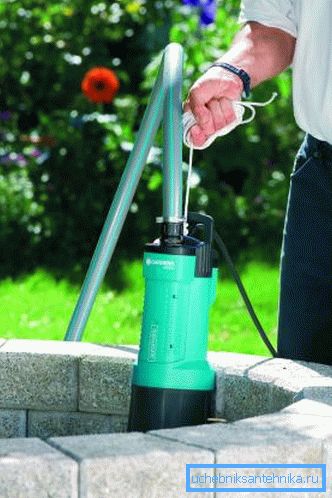
Differences between vibration and centrifugal submersible pumps
The principal difference between these two structures is the way that is used to supply liquid to the top. If we talk about centrifugal devices, then rotating elements are used.
Vibration pumps for wells are not equipped with rotating elements, and the water in them rises upward due to the movement of the piston or due to the elastic membrane. Such design features give clear advantages of vibration products, which consist in the simplicity of the device, a small number of parts and cheapness, since the price of the device is low.
Design and principle of operation of vibrating submersible pumps
Submersible vibrating pumps are not endowed with parts that rotate during operation; there are no bearings in their design that could fail over a long period of operation. The simple, but at the same time very successful design of these devices allows you to operate them without carrying out maintenance activities.
The basis of such a pump is its body, in which the electromagnet and the vibration mechanism are located. At the moment of connecting the device to the network, the anchor of its electric magnet begins to make translational movements and vibrate, directing the force on the rod, on which the piston is fixed.

As the instruction to the device says, water reaches the inlet through the piston movement, fills the chamber through a special valve, from where it enters the discharge hose when the piston moves backwards. The valve, which was mentioned, opposes the movement of fluid in two directions, preventing it from pouring out of the working chamber of the device.
Application area
Vibration type submersible pumps can be used as follows:
- Well pump. Small indicators of the pressure of the device determine its use only in shallow wells;
- Well pump. Such a pump can be used both for supplying clean water for drinking from the bottom of the well, and for the procedure of cleaning the well, which consists in pumping out water with admixtures of sand and clay;
- Water supply for technical needs. The pump can be used for pumping water from any reservoir, for example, for watering or for any other purposes.
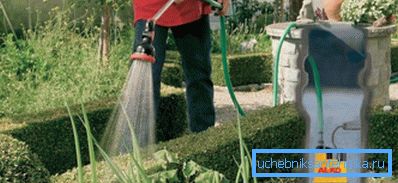
Design features
Vibrating pumps for wells or boreholes have a number of design features that should be mentioned:
- Small overall dimensions, low weight and ease of installation allow you to connect such a pump with your own hands, for which the instruction must be carefully read and observed;
- There is no need to perform additional actions, adjust or tighten the nuts, it is enough just to connect the device to the electrical network, install the water supply hose and lower it into the water. To immerse the pump, it must be accompanied by a strong kapron cord;
- Some models have a thermal protection function, which is implemented as a thermal switch, which turns off the pump when the temperature of the structure reaches 1000WITH;
- In order to prevent solid impurities from entering the product chamber, it is sufficient to install a special filter;
- There are models with the function of the upper water intake and lower. If your pump implements the upper water intake, you need to ensure that it always remains in the water, which eliminates the risk of overheating.
Note! Constructions in which the water intake chamber is located in the upper part are protected from sand and other heavy parts entering the device.
Choosing a pump
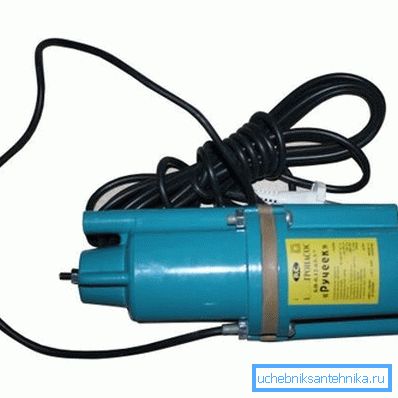
Anyone who wants to purchase such devices for their own use, thinks about which vibration pump to choose for a well?
Selecting the most appropriate model, you should pay attention to such characteristics as:
- Device power;
- Performance, which is expressed in the volume of pumped water for 1 unit of time;
- Head or height at which the device is capable of raising water.
Benefits of Immersion Vibration Structures
A vibratory pump for a well is a structure endowed with many distinct advantages:
- Unpretentious to use;
- Low noise level;
- Long service life;
- Lack of rotating parts and parts that need lubrication;
- Low heating of the product during operation;
- Low wear of the components of the structure;
- Not susceptible to alkalis, which may be in water;
- Uninterrupted operation in any temperature conditions;
- Mobility and compactness of the product.
Installation of a submersible vibration pump in the well
After you have answered yourself the question of which vibration pump to choose for the well and purchased it, you should be interested in the question of how to install it correctly and how to conduct water?
In reality, these tasks are not so difficult, but there are some nuances that you should definitely get acquainted with. Taking up the installation of such a pump costs two or even three, because working in a well shaft is associated with risk, and one person is not always able to pull the other from such depth.

Land works
Even before the start of the pump installation work itself, it is necessary to carry out all manipulations connected with the creation of a water supply system at a distance from the house to the well. To do this, dig a trench.
It is desirable that the trench remains flat, without turns and bends, this form will allow not to lose the force of pressure. To dig a trench should be at a depth of approximately 1-1.5 m.
So, dig a trench, the width of which is 40-50 cm. Make sure that at the bottom of the trench there are no sharp stones, glasses and debris.
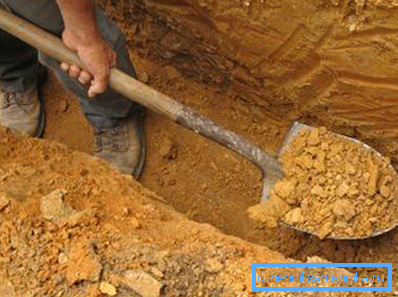
We put the sand cushion on the bottom of the trench, which consists of a layer of compacted sand 10-15 cm thick. The sand is carpeted with geotextile, which later will be wrapped pipe. After that, you can proceed directly to the laying of pipes.

Laying of water pipes
For the construction of plumbing on the street can be used several types of pipes:
- Steel tubes;
- Metal pipes;
- Stainless steel pipes;
- Polypropylene pipes;
- Soda hoses (suitable only for temporary plumbing).
The procedure itself broach plumbing is divided into the following steps:
- The sections of pipes are interconnected from the well to the house itself;
- The water pipe is wrapped with heat-insulating materials, and is pulled inside the pipe of a larger diameter. Asbestos or plastic sewage products are commonly used for this;
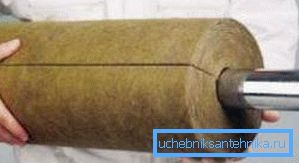
- The resulting structure is laid in the excavated trench and mark the place on the well wall, which will be inset;
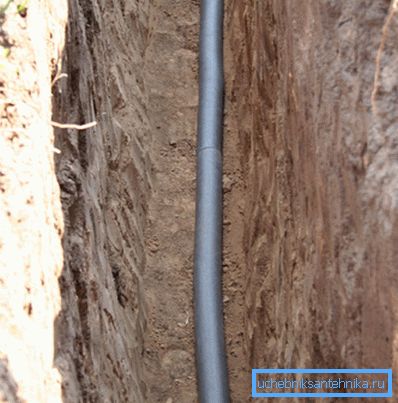
- In the wall of the shaft we cut a hole with a diameter of 15 cm. Insert a sleeve inside the hole, the length of which should not be less than 0.5 m.
- We pull the water supply into the sleeve in such a way that it enters the well shaft at least 25 cm;
- Finally, install the faucet and tee. Turning the pipe downwards leads to the place where the vibrating pump for the well is installed;
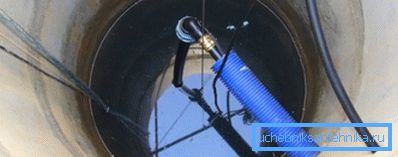
Council A tap with a tee should be installed, because a drain tap can be useful if you need an emergency drain of water from the plumbing system.
- Next, you should calculate the distance that will separate the valve from the pump and cut off the length of the water pipe.
Now you can go directly to the installation of the device.
Installation of the pump in the well

Vibration pumps for wells are suspended with a cable. Therefore, the first step is to weld a square frame from the corner, which is mounted on top of the tip.
It is necessary to tie the cable to this frame.
- On the ground, lay out the pipe, the pump and unwind the power cord for easy connection;
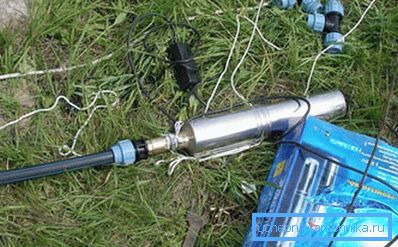
- At the inlet of the device, we install a check valve using sanitary packaging material;
- A plastic or brass coupling is attached to the non-return valve;
- Connect the coupling to the water pipe;
- We attach the electrical cable to the pipe with electrical tape or clamps with a slight slack in the wire;
- Attach a nylon or galvanized safety cable to the pump;
- This construction should be lowered into the well, holding the pump by the safety cable;
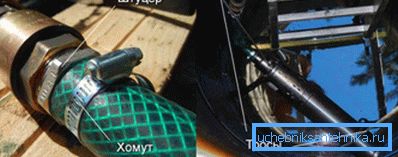
Note! Holding the pump by the power cable is strictly prohibited.
- Having lowered the pump on the necessary depth, it is necessary to tie a cable to a frame;
- To connect the pipe to the tap, one person must come down to the well, who will make the connection using tow or sanitary paste.
After the pump is installed electrical cable should be held to the place of installation of all plumbing equipment - accumulator, boiler and filters. When the pipe installation is finished, the pipeline should be covered with geotextile, covered with a layer of sand 10 cm thick and with soil.
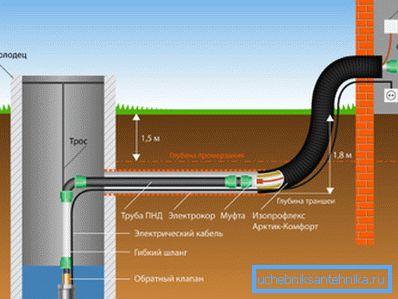
Vibrating pumps for wells is a great way to provide water for your own country house, these devices are inexpensive and are quite easy to install. And you can learn even more useful information about these devices by watching the video in this article.